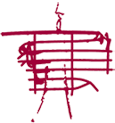TRIAL, ESSENHEIMER KUNSTVEREIN, Introduction by ANITA GRIMM-BORCHERT
Trial is the title of the exhibition. The stage for the main protagonists is set before me: the judge, the defendant and the female witness for the prosecution.
U.D attended several trials at Berlin's District Court in Moabit over a period of 11/2 years.
Confrontation with emotionally demanding events in the courtroom fascinated the artist. She has captured the pervading tension emenating from the authority of the judge and the incriminating evidence of the witness in the installation "Trial".
The relationship between the different materials and the connection between the sculpture and its environment are vital factors in UD's method of working, The same applies to the structure and quality of the surface and the way it reflects light. Colour is a lesser consideration, but is nevertheless used sparingly to accentuate expression. In order to detect these nuances, it is necessary to take a closer look.
The portrait occupies a central role is UD's work – not as a classical portrayal of a face but as a character study, a type-caste of an individual. The space dominated by BODO is a striking example of this.
The portait does not lay claim to recognition or physiognomical resemblance. The intention is to show analogies and "similarities solely through form". BODO conveys an impression of dynamism and expansion. The components appear to drift apart and simultaneously cling together.
Work in process, i.e the materials used (plaster, iron, polystyrene and the industially produced parts of the sculpture and the connections between the individual elements, whether inserted, glued or screwed together) are visible and recognisable in the bronze cast.
U.D does all the work on her sculptures herself prior to casting, i.e the female and wax mould and most of the carving and patination in order to maintain influence over all stages of production and the final result.











